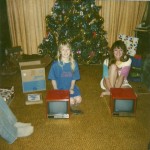rca
 After the Soviet Union launched Sputnik, the world’s first satellite, on October 4, 1957, inspiring the United States to keep up, or fall behind in the Cold War, the United States launched it’s first satellite on January 31, 1958. That satellite was called Explorer 1, and followed the first two Soviet satellites the previous year…Sputnik 1 and 2. It was the beginning the Cold War Space Race between the two nations. Explorer 1 had mercury batteries that powered the high-power transmitter for 31 days and the low-power transmitter for 105 days. Explorer 1 stopped transmission of data on May 23, 1958 when its batteries died, but remained in orbit for more than 12 years. It reentered the atmosphere over the Pacific Ocean on March 31, 1970 after more than 58,000 orbits. The Explorer 1 payload consisted of the Iowa Cosmic Ray Instrument. It was without a tape data recorder, which was not modified in time to make it onto the spacecraft. The real-time data received on the ground was therefore very sparse and puzzling showing normal counting rates and no counts at all. I’m not sure what the counting was all about, so I guess I’m more confused than the scientists were. The later Explorer 3 mission, which included a tape data recorder in the payload, provided the additional data for confirmation of the earlier Explorer 1 data.
After the Soviet Union launched Sputnik, the world’s first satellite, on October 4, 1957, inspiring the United States to keep up, or fall behind in the Cold War, the United States launched it’s first satellite on January 31, 1958. That satellite was called Explorer 1, and followed the first two Soviet satellites the previous year…Sputnik 1 and 2. It was the beginning the Cold War Space Race between the two nations. Explorer 1 had mercury batteries that powered the high-power transmitter for 31 days and the low-power transmitter for 105 days. Explorer 1 stopped transmission of data on May 23, 1958 when its batteries died, but remained in orbit for more than 12 years. It reentered the atmosphere over the Pacific Ocean on March 31, 1970 after more than 58,000 orbits. The Explorer 1 payload consisted of the Iowa Cosmic Ray Instrument. It was without a tape data recorder, which was not modified in time to make it onto the spacecraft. The real-time data received on the ground was therefore very sparse and puzzling showing normal counting rates and no counts at all. I’m not sure what the counting was all about, so I guess I’m more confused than the scientists were. The later Explorer 3 mission, which included a tape data recorder in the payload, provided the additional data for confirmation of the earlier Explorer 1 data.
Landsat 1, which was originally named “Earth Resources Technology Satellite 1”, was the first satellite in the United States’ Landsat program. It was the first satellite that was launched with the sole purpose of studying and monitoring the planet. Landsat 1 was a modified version of the Nimbus 4 meteorological satellite and was launched on July 23, 1972 by a Delta 900 rocket from Vandenberg Air Force Base in California. Its orbit was near-polar and it served as a stabilized, Earth-oriented platform for obtaining information on agricultural and forestry resources, geology and mineral resources, hydrology and water resources, geography, cartography, environmental pollution, oceanography and marine resources, and meteorological phenomena. The spacecraft was placed in a sun-synchronous orbit, with an altitude between 564 and 569 miles. The spacecraft was placed in an orbit with an inclination of 99 degrees which orbited the Earth every 103 minutes. The project was renamed to Landsat in 1975.
Landsat 1 had two sensors to achieve its primary objectives…the return beam Vidicon (RBV) and the multispectral scanner (MSS). The RBV was manufactured by the Radio Corporation of America (RCA). The RBV obtained visible light and near infrared photographic images of Earth. It was considered the primary sensor. The MSS sensor manufactured by Hughes Aircraft Company was considered an experimental and secondary sensor, until scientists reviewed the data that was beamed back to Earth. After the data was reviewed, the MSS  was considered the primary sensor. The MSS was a four-channel scanner that obtained radiometric images of Earth. From launch until 1974, Landsat 1 transmitted over 100,000 images, which covered more than 75% of the Earth’s surface. The RBV only took 1690 images. In 1976, Landsat 1 discovered a tiny uninhabited island 12 miles off the eastern coast of Canada. This island was named Landsat Island after the satellite. The MSS provided more than 300,000 images over the lifespan of the satellite. NASA oversaw 300 researchers that evaluated the data that Landsat 1 transmitted back to Earth. The Landsat 1 satellite sent data back to earth from its orbit until January of 1978 when its tape recorders malfunctioned. After that, it was taken out of service.
was considered the primary sensor. The MSS was a four-channel scanner that obtained radiometric images of Earth. From launch until 1974, Landsat 1 transmitted over 100,000 images, which covered more than 75% of the Earth’s surface. The RBV only took 1690 images. In 1976, Landsat 1 discovered a tiny uninhabited island 12 miles off the eastern coast of Canada. This island was named Landsat Island after the satellite. The MSS provided more than 300,000 images over the lifespan of the satellite. NASA oversaw 300 researchers that evaluated the data that Landsat 1 transmitted back to Earth. The Landsat 1 satellite sent data back to earth from its orbit until January of 1978 when its tape recorders malfunctioned. After that, it was taken out of service.
 Television was invented by a 21 year old man named Philo Taylor Farnsworth, and first successfully demonstrated in San Francisco on Sept. 7, 1927. It’s odd to think that my dad, Allen Spencer lived both before the invention of television and after it. I suppose that isn’t so very odd, because I have lived before and after the cell phone, and that doesn’t seem strange to me at all, so I suppose it didn’t seem strange to my dad either. Then, on March 25, 1954…just a month and a half before my sister, Cheryl Masterson was born, RCA announced that it had begun producing the first color television sets in its Bloomington, Indiana plant.
Television was invented by a 21 year old man named Philo Taylor Farnsworth, and first successfully demonstrated in San Francisco on Sept. 7, 1927. It’s odd to think that my dad, Allen Spencer lived both before the invention of television and after it. I suppose that isn’t so very odd, because I have lived before and after the cell phone, and that doesn’t seem strange to me at all, so I suppose it didn’t seem strange to my dad either. Then, on March 25, 1954…just a month and a half before my sister, Cheryl Masterson was born, RCA announced that it had begun producing the first color television sets in its Bloomington, Indiana plant.
I’m sure it was a while before most homes made the move to color televisions, and  then, of course, there was the wait for shows to be filmed in color. I know that I remember watching a black and white television, and I’m sure most people my age can say the same. The current generation would have no idea what it was like to watch a black and white television, or an early color television. They have seen everything from HD television, to cell phones with television, as well as tablets. The old televisions would seem completely antiquated…and in reality, my generation would look at them that way too. It amazes me just how quickly we get used to new technology, and it amazes me just how long people will hold on to the old stuff before making the transition too. I suppose some think that if it isn’t broken, there is no reason to replace it just yet, but others simply wait until the see how well this new fangled gadget is going to work, or if it’s around very long. So many fads come and go, and are never
then, of course, there was the wait for shows to be filmed in color. I know that I remember watching a black and white television, and I’m sure most people my age can say the same. The current generation would have no idea what it was like to watch a black and white television, or an early color television. They have seen everything from HD television, to cell phones with television, as well as tablets. The old televisions would seem completely antiquated…and in reality, my generation would look at them that way too. It amazes me just how quickly we get used to new technology, and it amazes me just how long people will hold on to the old stuff before making the transition too. I suppose some think that if it isn’t broken, there is no reason to replace it just yet, but others simply wait until the see how well this new fangled gadget is going to work, or if it’s around very long. So many fads come and go, and are never  heard from again. Others, like televisions, cell phones, and computers are here to stay.
heard from again. Others, like televisions, cell phones, and computers are here to stay.
Television sets have gone from average size to ultra big, to ultra small, and everything in between. Of course, as we all know, the television has continues to improve in color and clarity too. Sometimes I think the color is almost better than real life…if that’s possible. With new abilities in editing, color can be enhanced to amazing levels. I’m sure that there are some people who would think enhanced color is not a good thing, and sometimes…if it seems completely outlandish, I would have to agree, but when it comes to watching television, I think they do a pretty good job, and I can’t imagine going back to a black and white television.

